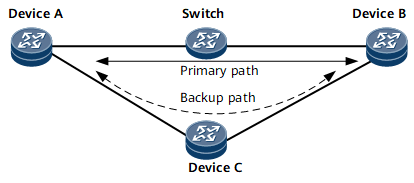BFD for IS-IS
In most cases, the interval at which Hello packets are sent is 10s, and the IS-IS neighbor holding time (the timeout period of a neighbor relationship) is three times the interval. If a device does not receive a Hello packet from its neighbor within the holding time, the device terminates the neighbor relationship.
A device can detect neighbor faults at the second level only. As a result, link faults on a high-speed network may cause a large number of packets to be discarded.
BFD, which can be used to detect link faults on lightly loaded networks at the millisecond level, is introduced to resolve the preceding issue. With BFD, two systems periodically send BFD packets to each other. If a system does not receive BFD packets from the other end within a specified period, the system considers the bidirectional link between them Down.

Instead of replacing the Hello mechanism of IS-IS, BFD works with IS-IS to rapidly detect the faults that occur on neighboring devices or links.
BFD Session Establishment and Deletion
Process of establishing a BFD session
-
After the conditions for establishing BFD sessions are met, IS-IS instructs the BFD module to establish a BFD session and negotiate BFD parameters between neighbors.
-
After the conditions for establishing BFD sessions are met and the DIS is elected, IS-IS instructs BFD to establish a BFD session and negotiate BFD parameters between the DIS and each device. No BFD sessions are established between non-DISs.
On broadcast networks, devices (including non-DIS devices) of the same level on a network segment can establish adjacencies. In BFD for IS-IS, however, BFD sessions are established only between the DIS and non-DISs. On P2P networks, BFD sessions are directly established between neighbors.
If a Level-1-2 neighbor relationship is set up between the devices on both ends of a link, the following situations occur:- On a broadcast network, IS-IS sets up a Level-1 BFD session and a Level-2 BFD session.
- On a P2P network, IS-IS sets up only one BFD session.
-
Process of tearing down a BFD session
-
If the neighbor relationship established between P2P IS-IS interfaces is not Up, IS-IS tears down the BFD session.
-
If the neighbor relationship established between broadcast IS-IS interfaces is not Up or the DIS is reelected on the broadcast network, IS-IS tears down the BFD session.
If the configurations of dynamic BFD sessions are deleted or BFD for IS-IS is disabled from an interface, all Up BFD sessions established between the interface and its neighbors are deleted. If the interface is a DIS and the DIS is Up, all BFD sessions established between the interface and its neighbors are deleted.
If BFD is disabled from an IS-IS process, BFD sessions are deleted from the process.

BFD detects only the one-hop link between IS-IS neighbors because IS-IS establishes only one-hop neighbor relationships.
-
Usage Scenario

Dynamic BFD needs to be configured based on the actual network. If the time parameters are not configured correctly, network flapping may occur.
BFD for IS-IS speeds up route convergence through rapid link failure detection. The following is a networking example for BFD for IS-IS.
The configuration requirements are as follows:
Basic IS-IS functions are configured on each device shown in Figure 1.
If the link between Device A and Device B fails, BFD can rapidly detect the fault and report it to IS-IS. IS-IS sets the neighbor status to Down to trigger an IS-IS topology calculation. IS-IS also updates LSPs so that Device C can promptly receive the updated LSPs from Device B, which accelerates network topology convergence.
